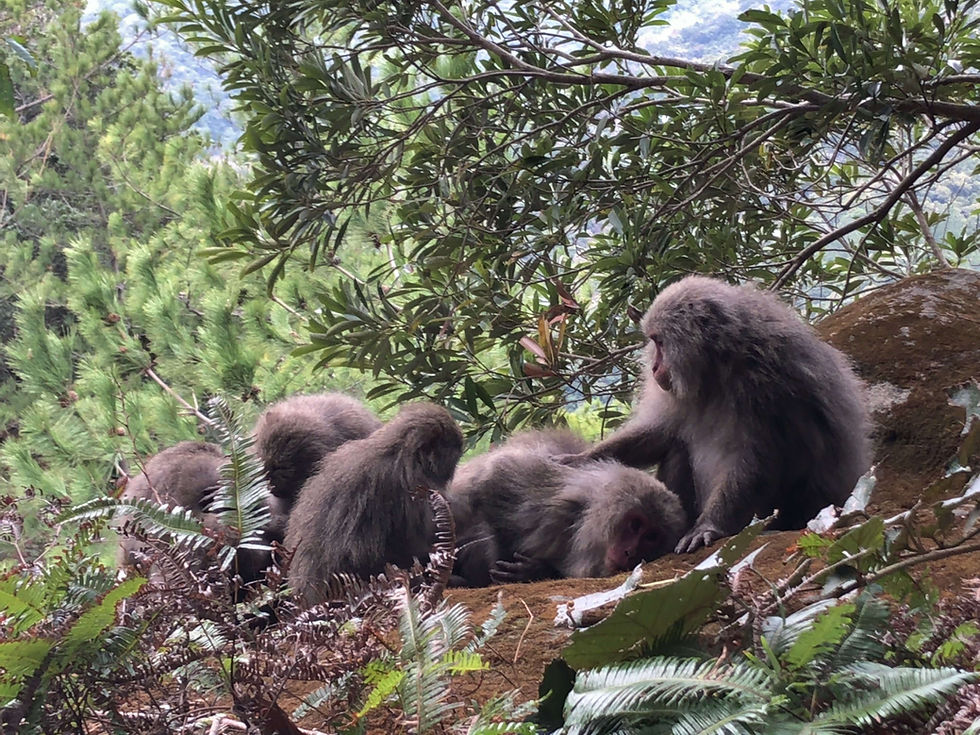Camellia japonica: The History, Culture, and Ecology of Tsubaki, the Japanese Camellia
- tokyonaturalist
- May 1, 2022
- 7 min read
Updated: May 4, 2022
English Common Name: Japanese camellia
Japanese (Kanji): 椿
Japanese (Katakana): ツバキ
Pronunciation: Tsubaki

Perhaps one of the most striking trees in Tokyo in winter is Camellia japonica, a shrub or small tree species that is native to southern Japan and China. Known as tsubaki in Japan,this species is iconic for its beautiful white, pink, or red flowers that appear from late winter to early spring as well as its thick, glossy, and evergreen leaves. In addition to its aesthetic value in wintertime gardens, the cultural, ecological, and historical impact of Camellia japonica is wide-ranging, from playing a role in early diplomacy between Japan and China to its usage as a symbol for those fleeing religious persecution during the Edo period.
Camellia japonica in Early Japan: Oil, Poetry, and Diplomacy
The Japanese name tsubaki (ツバキ or 藪椿) is thought to derive either from the word Atsu-ba-ki (厚葉木), which means "thick-leaf tree," or Tsuya-ba-ki (艶葉木), which translates to "glossy-leaf tree." In Japan, it is found in a wide range of habitats, from coastal to mountainous regions, in addition to places where it is cultivated as an ornamental tree or for agricultural purposes.
Though its flowers that bloom in winter have long made it a desirable garden tree, its fruit that ripens in the fall have been harvested and utilized since at least 2,300 years ago during the Jomon period in Japan. It is from this fruit that camellia oil is derived - first they are dried in the sun and then pulverized and heated with steam, which results in increased pressure that allows oil to be extracted and then filtered through washi paper. Camellia oil has historically been utilized as a remedy for irritated skin and other medicinal purposes because of its anti-inflammatory properties, as well as a fuel source and a cooking oil.

In addition to its utilitarian purposes, tsubaki oil also played a diplomatic role in early missions between Japan and China. From approximately 607 C.E. to 839 C.E., Japan sent political and cultural representatives to China on a series of missions called kentōshi that resulted in important political, technological, religious, and cultural exchange between the two nations. Among the gifts the Japanese envoys brought on these critical diplomatic missions was Japanese camellia oil. In fact, one old name for Camellia japonica in China is “海石榴,” which literally means “pomegranate that came from overseas.” Some suspect it might have been called this because of the camellia oil given to China from Japan during the kentōshi. Later on during the Song dynasty (960 C.E.–1279 C.E.) Japanese camellias were bred extensively in China, where grafting was used to create many new varieties of the species.
One other piece of evidence that points to the importance of Japanese camellias during this period comes from the oldest collection of classical Japanese poetry. This collection, called the Man'yōshū (万葉集), is a set of poems dated between 600 C.E. and 759 C.E. and is often considered a crucial foundational block of Japanese literature. Nature and the changing of seasons feature as prominent themes and metaphors in the Man'yōshū, in which over 150 species of plants are mentioned. Camellia japonica is mentioned in nine poems in the collection, indicating its cultural importance in the early historical periods of Japan.
Japanese Camellias in the Edo Period: Tokugawa Cultivation and Religious Persecution
In the Edo period (1603-1867), Japanese camellias experienced another surge in popularity, in which camellia oil was widely used as a hair treatment. Perhaps this widespread popularity was due, in part, to the popularity of Camellia japonica amongst the Tokugawa shoguns, many of whom had substantial interest in the cultivation of flowering plant species. The second Tokugawa shogun, Tokugawa Hidetada, was particularly interested in camellias. As a result, many daimyo (feudal lords) also adopted an interest in Japanese camellias and began cultivating new varieties in efforts to win the shogun's favor, effectively spreading a "camellia boom" across Japan in the early 17th century. An essay published in 1630 by the monk Anrakuan Sakuden indicated that over 100 varieties of the plant had been cultivated by that time. Later on in the 18th century, interest in Trident Maples (Acer buergerianum) spread across Japan in a similar way after the shogun Tokugawa Ienobu made multi-colored maples the "in-fashion" plant of the time.

During the Edo period, the Japanese camellia was also an important symbol to another group in Japan outside of the Japanese nobility: the "hidden Christians" (隠れキリシタン), who were the Catholics who went into hiding as the result of religious persecution carried out by the Tokugawa shogunate. Many fled to the Goto Islands, a group of islands found off the western coast of Nagasaki. As a result of this persecution, it was not safe to openly display religious symbols or statues associated with Christianity. Instead, many hidden Christians adopted a new symbol, one that grew wildly and in large numbers across the islands: the tsubaki flower, which some associated with spiritual endurance, while others associated the flower with the Virgin Mary. Today, churches on the Goto Islands often still bear the image of camellias.
Modern Associations with Tsubaki
Today, camellias grow wildly throughout Japan, and are often planted in parks and gardens. Camellia oil remains an important product that the species provides. It is recognized as a high-quality natural oil, is used in modern haircare and cosmetic products, and can also be used in cooking. Cultural traditions associated with Camellia japonica the remain include avoiding it as a gift for sick and hospitalized people. This is because when the plant ends its flowering period, the entire flower falls to the ground, rather than petal by petal. Because, for some in the past, this symbolized the head falling from its body, giving tsubaki flowers to those in the hospital may be seen as impolite.
Although giving these flowers as a gift can be taboo because of their tendency to fall to the ground in one piece, it also serves as a helpful way to distinguish Camellia japonica from another species with which it is often confused: Camellia sasanqua (山茶花, サザンカ or "sazanka"). Unlike the Japanese Camellia, the Sasanqua Camellia flower falls to the ground petal by petal.
Ecological Roles: Monkeys and Evolutionary Arms Races
In addition to its rich cultural and historical legacies in Japan, Japanese camellias also play an important ecological role for a number of Japanese bird and animal species. Birds like the Warbling White-Eye (Zosterops japonicus, メジロ) and the Brown-Eared Bulbul (Hypsipetes amaurotis, ヒヨドリ) have a mutualistic relationship with the tree, frequently visiting their flowers for nectar and pollinating those flowers in return. In addition, the nectar of tsubaki flowers provides an important food source for Japanese macaques (Macaca fuscata, ニホンザル or "Nihon-zaru) in early spring on the southern Japanese island of Yakushima.

The Japanese camellia also gives us a fascinating example of an evolutionary arms race - a term used to describe when species evolve new adaptations to resist or attack a competitor, which in turn causes that competitor to evolve a new offensive or defensive behavior in an "escalating" feedback loop. These relationships sometimes result in the exaggeration of certain physical features, like extraordinarily long tongues, or in the resistance to certain toxins. In the case of Camellia japonica, camellia weevils (Curculio camelliae) are the competitor in question, whose long rostrum (or snout) is used to bore into the large fruit of the camellia tree in order to lay its eggs inside. However, the pericarp, or the outer fruit wall, of Camellia japonica is very thick. As a result, trees whose fruit have thicker pericarps are more successful at fending off camellia weevils whose snouts are not long enough to break through their pericarps. Some studies have suggested that this dynamic points to an arms race between the two species - resulting, over time, in increasingly longer snouts and thicker pericarps.
Today, Camellia japonica is widely planted as an ornamental species around the world and is celebrated for its vibrant blooms in winter and early spring, with over 2,000 different cultivars in existence. Although cultural and historical factors in Japanese history greatly shaped the cultivation and appearance of the plant over time, Camellia japonica in turn helped shape parts of Japanese history and culture. Whether by providing a symbol for the religiously persecuted to gather behind, or by helping to ensure diplomatic cooperation between Japan and China over a thousand years ago, Camellia japonica serves as an excellent example of how the natural world shapes human history as much as we shape it.
More Photos:
All photography by Siri McGuire.
Additional Sources:
Hanya, G. (2004). Seasonal variations in the activity budget of Japanese macaques in the coniferous forest of Yakushima: effects of food and temperature. American Journal of Primatology: Official Journal of the American Society of Primatologists, 63(3), 165-177.
Kingsbury, N. (2016). Garden Flora: The Natural and Cultural History of the Plants in Your Garden. Timber Press.
Lee, S. Y., Hwang, E. J., Kim, G. H., Choi, Y. B., Lim, C. Y., & Kim, S. M. (2005). Antifungal and Antioxidant Activities of Extracts from Leaves and Flowers of Camellia japonica L. Korean Journal of Medicinal Crop Science, 13(3), 93-100.
Toju, H., & Sota, T. (2006). Adaptive divergence of scaling relationships mediates the arms race between a weevil and its host plant. Biology Letters, 2(4), 539-542.
はじめての万葉集 Vol. 8” 県民だより奈良 奈良県公式サイト, Dec. 2014
“椿油” 東京都大島町公式サイト 伊豆大島のツバキ ポータルサイト, 29 Dec. 2016
Field Guides Consulted:
Title: 葉っぱで見分け五感で楽しむ樹木図鑑 (Happa de miwake gokan de tanoshimu jumokuzukan)
Author: 林将之 (Hayashi Masayuki)
Publishing Date and Publisher: 2014, ナツメ社
Language: Japanese
Title: 樹皮・葉でわかる樹木図鑑 (Juhi・Hadewakaru jumokuzukan)
Author: 菱山忠三郎 (Hishiyama Chuzaburo)
Publishing Date and Publisher: 2011, 成美堂出版
Language: Japanese
























Comments